Analyzing HR's Role in Whirlpool's Restructuring: A Performance Report
VerifiedAdded on 2021/01/01
|15
|5015
|316
Report
AI Summary
This report examines the case of Whirlpool's organizational crisis and the crucial role of HR in its restructuring. It highlights the skills, knowledge, and behaviors required by HR professionals to create a high-performance work system, including communication, teamwork, value chain knowledge, legal regulations, accountability, and conflict management. The report includes a personal skills audit, identifying strengths and weaknesses of an HR professional and proposes a development plan to address areas needing improvement. Furthermore, it discusses organizational learning, differentiating between single and double-loop learning, and the importance of learning organizations. The report also explores different learning styles and their impact on training and development, along with the differences between organizational and individual learning, as well as training and development. This report provides valuable insights into how HR can drive organizational change, improve performance, and foster a culture of commitment within a company facing significant challenges.
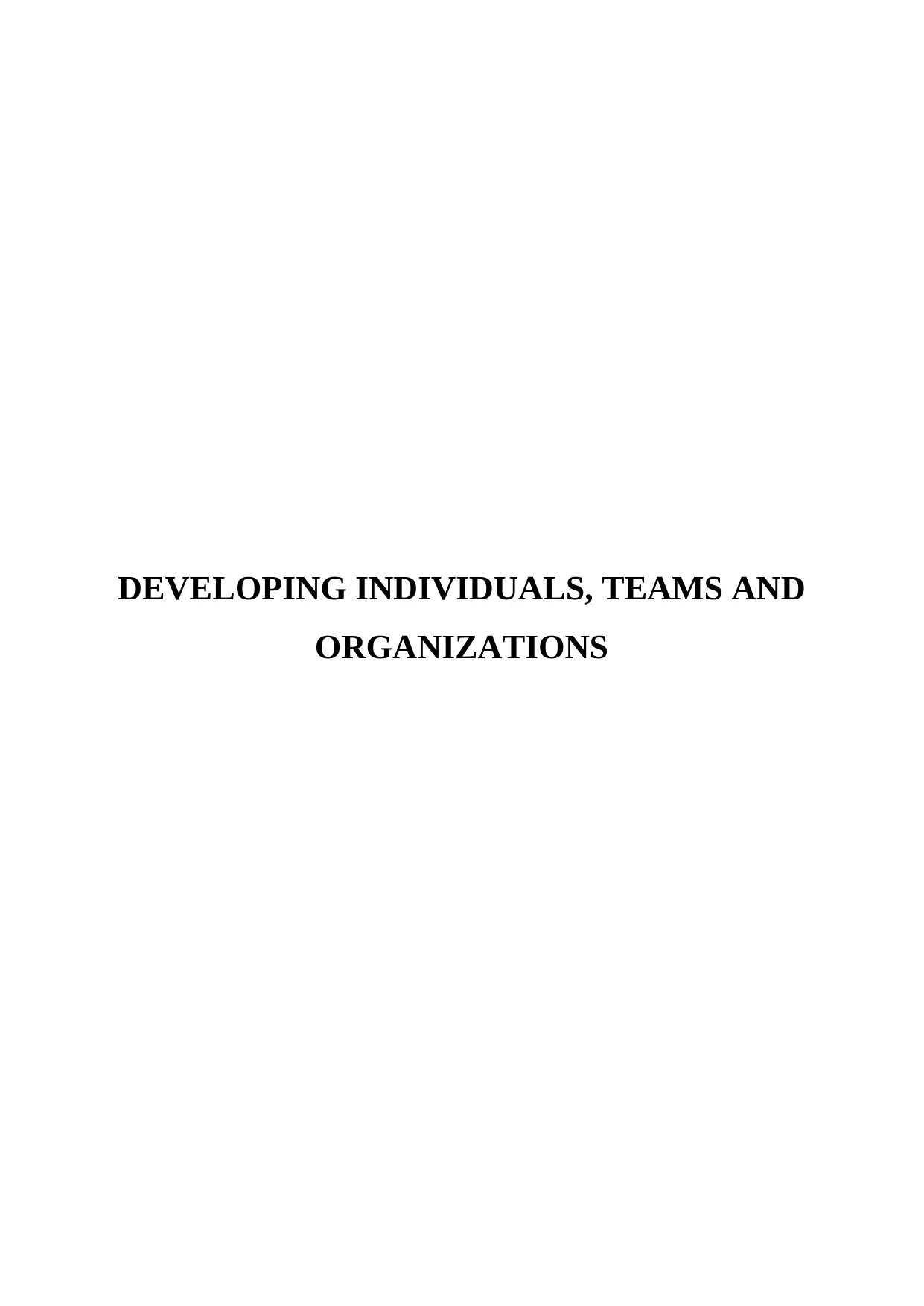
DEVELOPING INDIVIDUALS, TEAMS AND
ORGANIZATIONS
ORGANIZATIONS
Paraphrase This Document
Need a fresh take? Get an instant paraphrase of this document with our AI Paraphraser
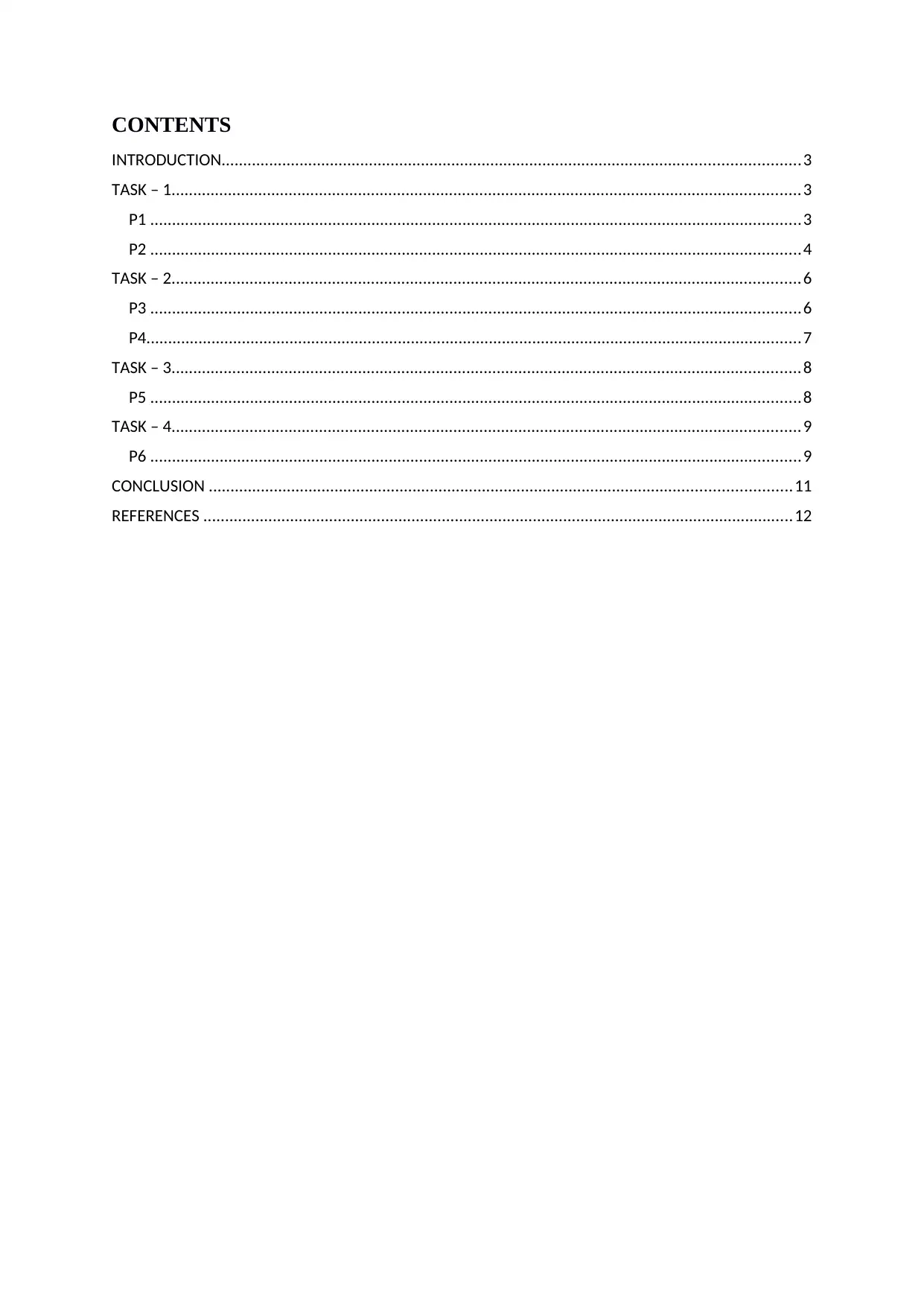
CONTENTS
INTRODUCTION.....................................................................................................................................3
TASK – 1.................................................................................................................................................3
P1 ......................................................................................................................................................3
P2 ......................................................................................................................................................4
TASK – 2.................................................................................................................................................6
P3 ......................................................................................................................................................6
P4.......................................................................................................................................................7
TASK – 3.................................................................................................................................................8
P5 ......................................................................................................................................................8
TASK – 4.................................................................................................................................................9
P6 ......................................................................................................................................................9
CONCLUSION ......................................................................................................................................11
REFERENCES ........................................................................................................................................12
INTRODUCTION.....................................................................................................................................3
TASK – 1.................................................................................................................................................3
P1 ......................................................................................................................................................3
P2 ......................................................................................................................................................4
TASK – 2.................................................................................................................................................6
P3 ......................................................................................................................................................6
P4.......................................................................................................................................................7
TASK – 3.................................................................................................................................................8
P5 ......................................................................................................................................................8
TASK – 4.................................................................................................................................................9
P6 ......................................................................................................................................................9
CONCLUSION ......................................................................................................................................11
REFERENCES ........................................................................................................................................12
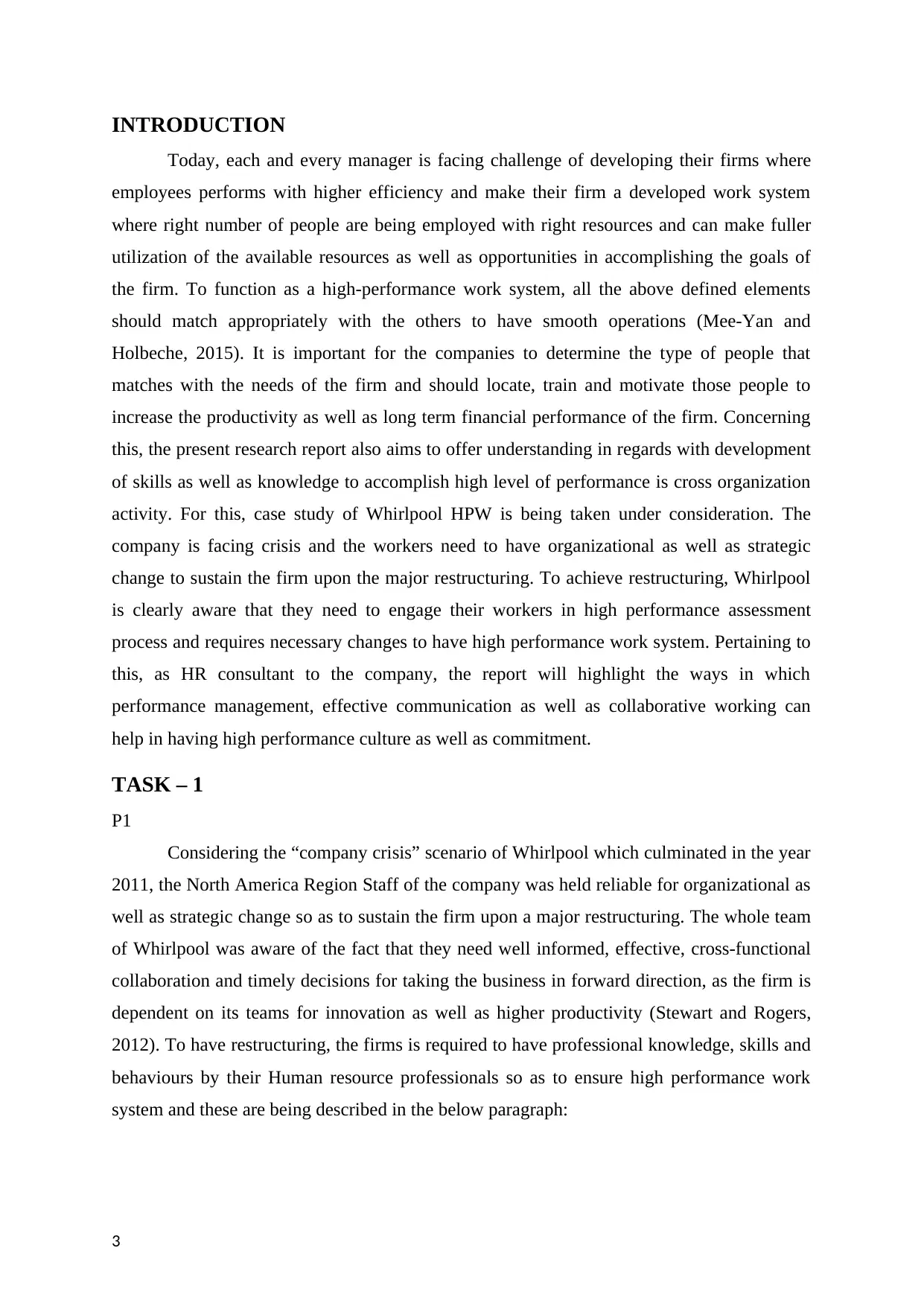
INTRODUCTION
Today, each and every manager is facing challenge of developing their firms where
employees performs with higher efficiency and make their firm a developed work system
where right number of people are being employed with right resources and can make fuller
utilization of the available resources as well as opportunities in accomplishing the goals of
the firm. To function as a high-performance work system, all the above defined elements
should match appropriately with the others to have smooth operations (Mee-Yan and
Holbeche, 2015). It is important for the companies to determine the type of people that
matches with the needs of the firm and should locate, train and motivate those people to
increase the productivity as well as long term financial performance of the firm. Concerning
this, the present research report also aims to offer understanding in regards with development
of skills as well as knowledge to accomplish high level of performance is cross organization
activity. For this, case study of Whirlpool HPW is being taken under consideration. The
company is facing crisis and the workers need to have organizational as well as strategic
change to sustain the firm upon the major restructuring. To achieve restructuring, Whirlpool
is clearly aware that they need to engage their workers in high performance assessment
process and requires necessary changes to have high performance work system. Pertaining to
this, as HR consultant to the company, the report will highlight the ways in which
performance management, effective communication as well as collaborative working can
help in having high performance culture as well as commitment.
TASK – 1
P1
Considering the “company crisis” scenario of Whirlpool which culminated in the year
2011, the North America Region Staff of the company was held reliable for organizational as
well as strategic change so as to sustain the firm upon a major restructuring. The whole team
of Whirlpool was aware of the fact that they need well informed, effective, cross-functional
collaboration and timely decisions for taking the business in forward direction, as the firm is
dependent on its teams for innovation as well as higher productivity (Stewart and Rogers,
2012). To have restructuring, the firms is required to have professional knowledge, skills and
behaviours by their Human resource professionals so as to ensure high performance work
system and these are being described in the below paragraph:
3
Today, each and every manager is facing challenge of developing their firms where
employees performs with higher efficiency and make their firm a developed work system
where right number of people are being employed with right resources and can make fuller
utilization of the available resources as well as opportunities in accomplishing the goals of
the firm. To function as a high-performance work system, all the above defined elements
should match appropriately with the others to have smooth operations (Mee-Yan and
Holbeche, 2015). It is important for the companies to determine the type of people that
matches with the needs of the firm and should locate, train and motivate those people to
increase the productivity as well as long term financial performance of the firm. Concerning
this, the present research report also aims to offer understanding in regards with development
of skills as well as knowledge to accomplish high level of performance is cross organization
activity. For this, case study of Whirlpool HPW is being taken under consideration. The
company is facing crisis and the workers need to have organizational as well as strategic
change to sustain the firm upon the major restructuring. To achieve restructuring, Whirlpool
is clearly aware that they need to engage their workers in high performance assessment
process and requires necessary changes to have high performance work system. Pertaining to
this, as HR consultant to the company, the report will highlight the ways in which
performance management, effective communication as well as collaborative working can
help in having high performance culture as well as commitment.
TASK – 1
P1
Considering the “company crisis” scenario of Whirlpool which culminated in the year
2011, the North America Region Staff of the company was held reliable for organizational as
well as strategic change so as to sustain the firm upon a major restructuring. The whole team
of Whirlpool was aware of the fact that they need well informed, effective, cross-functional
collaboration and timely decisions for taking the business in forward direction, as the firm is
dependent on its teams for innovation as well as higher productivity (Stewart and Rogers,
2012). To have restructuring, the firms is required to have professional knowledge, skills and
behaviours by their Human resource professionals so as to ensure high performance work
system and these are being described in the below paragraph:
3
⊘ This is a preview!⊘
Do you want full access?
Subscribe today to unlock all pages.

Trusted by 1+ million students worldwide
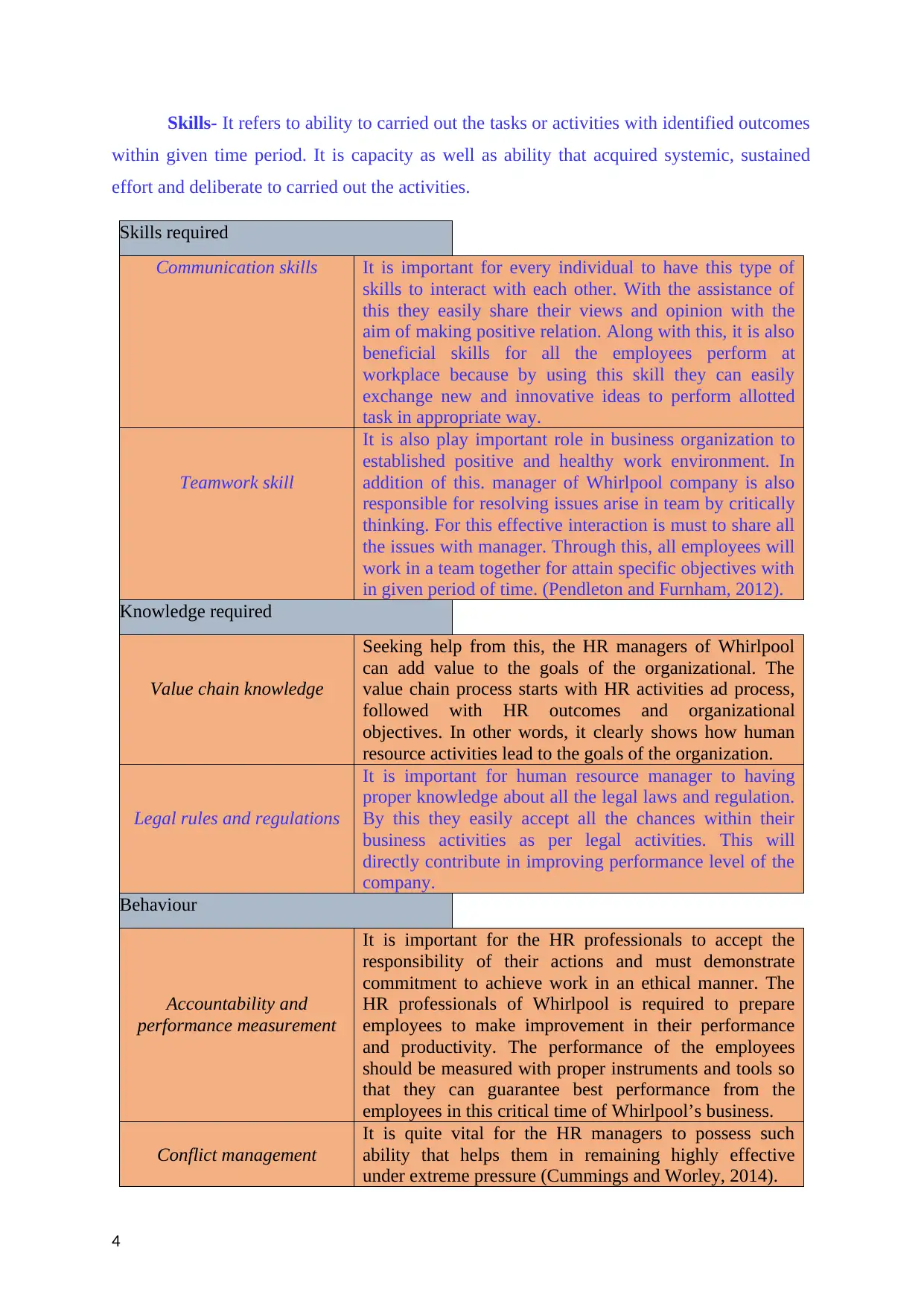
Skills- It refers to ability to carried out the tasks or activities with identified outcomes
within given time period. It is capacity as well as ability that acquired systemic, sustained
effort and deliberate to carried out the activities.
Skills required
Communication skills It is important for every individual to have this type of
skills to interact with each other. With the assistance of
this they easily share their views and opinion with the
aim of making positive relation. Along with this, it is also
beneficial skills for all the employees perform at
workplace because by using this skill they can easily
exchange new and innovative ideas to perform allotted
task in appropriate way.
Teamwork skill
It is also play important role in business organization to
established positive and healthy work environment. In
addition of this. manager of Whirlpool company is also
responsible for resolving issues arise in team by critically
thinking. For this effective interaction is must to share all
the issues with manager. Through this, all employees will
work in a team together for attain specific objectives with
in given period of time. (Pendleton and Furnham, 2012).
Knowledge required
Value chain knowledge
Seeking help from this, the HR managers of Whirlpool
can add value to the goals of the organizational. The
value chain process starts with HR activities ad process,
followed with HR outcomes and organizational
objectives. In other words, it clearly shows how human
resource activities lead to the goals of the organization.
Legal rules and regulations
It is important for human resource manager to having
proper knowledge about all the legal laws and regulation.
By this they easily accept all the chances within their
business activities as per legal activities. This will
directly contribute in improving performance level of the
company.
Behaviour
Accountability and
performance measurement
It is important for the HR professionals to accept the
responsibility of their actions and must demonstrate
commitment to achieve work in an ethical manner. The
HR professionals of Whirlpool is required to prepare
employees to make improvement in their performance
and productivity. The performance of the employees
should be measured with proper instruments and tools so
that they can guarantee best performance from the
employees in this critical time of Whirlpool’s business.
Conflict management
It is quite vital for the HR managers to possess such
ability that helps them in remaining highly effective
under extreme pressure (Cummings and Worley, 2014).
4
within given time period. It is capacity as well as ability that acquired systemic, sustained
effort and deliberate to carried out the activities.
Skills required
Communication skills It is important for every individual to have this type of
skills to interact with each other. With the assistance of
this they easily share their views and opinion with the
aim of making positive relation. Along with this, it is also
beneficial skills for all the employees perform at
workplace because by using this skill they can easily
exchange new and innovative ideas to perform allotted
task in appropriate way.
Teamwork skill
It is also play important role in business organization to
established positive and healthy work environment. In
addition of this. manager of Whirlpool company is also
responsible for resolving issues arise in team by critically
thinking. For this effective interaction is must to share all
the issues with manager. Through this, all employees will
work in a team together for attain specific objectives with
in given period of time. (Pendleton and Furnham, 2012).
Knowledge required
Value chain knowledge
Seeking help from this, the HR managers of Whirlpool
can add value to the goals of the organizational. The
value chain process starts with HR activities ad process,
followed with HR outcomes and organizational
objectives. In other words, it clearly shows how human
resource activities lead to the goals of the organization.
Legal rules and regulations
It is important for human resource manager to having
proper knowledge about all the legal laws and regulation.
By this they easily accept all the chances within their
business activities as per legal activities. This will
directly contribute in improving performance level of the
company.
Behaviour
Accountability and
performance measurement
It is important for the HR professionals to accept the
responsibility of their actions and must demonstrate
commitment to achieve work in an ethical manner. The
HR professionals of Whirlpool is required to prepare
employees to make improvement in their performance
and productivity. The performance of the employees
should be measured with proper instruments and tools so
that they can guarantee best performance from the
employees in this critical time of Whirlpool’s business.
Conflict management
It is quite vital for the HR managers to possess such
ability that helps them in remaining highly effective
under extreme pressure (Cummings and Worley, 2014).
4
Paraphrase This Document
Need a fresh take? Get an instant paraphrase of this document with our AI Paraphraser
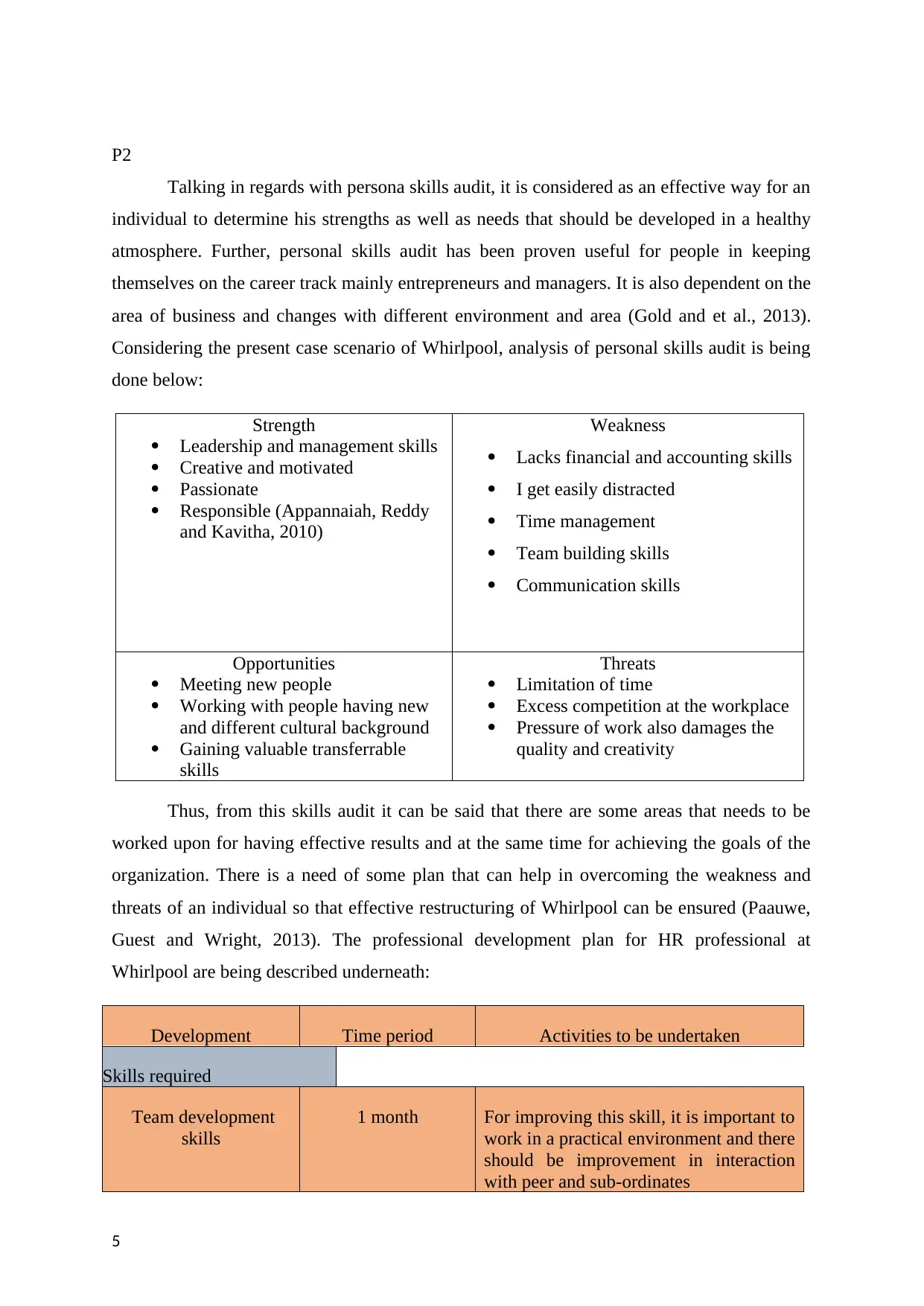
P2
Talking in regards with persona skills audit, it is considered as an effective way for an
individual to determine his strengths as well as needs that should be developed in a healthy
atmosphere. Further, personal skills audit has been proven useful for people in keeping
themselves on the career track mainly entrepreneurs and managers. It is also dependent on the
area of business and changes with different environment and area (Gold and et al., 2013).
Considering the present case scenario of Whirlpool, analysis of personal skills audit is being
done below:
Strength
Leadership and management skills
Creative and motivated
Passionate
Responsible (Appannaiah, Reddy
and Kavitha, 2010)
Weakness
Lacks financial and accounting skills
I get easily distracted
Time management
Team building skills
Communication skills
Opportunities
Meeting new people
Working with people having new
and different cultural background
Gaining valuable transferrable
skills
Threats
Limitation of time
Excess competition at the workplace
Pressure of work also damages the
quality and creativity
Thus, from this skills audit it can be said that there are some areas that needs to be
worked upon for having effective results and at the same time for achieving the goals of the
organization. There is a need of some plan that can help in overcoming the weakness and
threats of an individual so that effective restructuring of Whirlpool can be ensured (Paauwe,
Guest and Wright, 2013). The professional development plan for HR professional at
Whirlpool are being described underneath:
Development Time period Activities to be undertaken
Skills required
Team development
skills
1 month For improving this skill, it is important to
work in a practical environment and there
should be improvement in interaction
with peer and sub-ordinates
5
Talking in regards with persona skills audit, it is considered as an effective way for an
individual to determine his strengths as well as needs that should be developed in a healthy
atmosphere. Further, personal skills audit has been proven useful for people in keeping
themselves on the career track mainly entrepreneurs and managers. It is also dependent on the
area of business and changes with different environment and area (Gold and et al., 2013).
Considering the present case scenario of Whirlpool, analysis of personal skills audit is being
done below:
Strength
Leadership and management skills
Creative and motivated
Passionate
Responsible (Appannaiah, Reddy
and Kavitha, 2010)
Weakness
Lacks financial and accounting skills
I get easily distracted
Time management
Team building skills
Communication skills
Opportunities
Meeting new people
Working with people having new
and different cultural background
Gaining valuable transferrable
skills
Threats
Limitation of time
Excess competition at the workplace
Pressure of work also damages the
quality and creativity
Thus, from this skills audit it can be said that there are some areas that needs to be
worked upon for having effective results and at the same time for achieving the goals of the
organization. There is a need of some plan that can help in overcoming the weakness and
threats of an individual so that effective restructuring of Whirlpool can be ensured (Paauwe,
Guest and Wright, 2013). The professional development plan for HR professional at
Whirlpool are being described underneath:
Development Time period Activities to be undertaken
Skills required
Team development
skills
1 month For improving this skill, it is important to
work in a practical environment and there
should be improvement in interaction
with peer and sub-ordinates
5
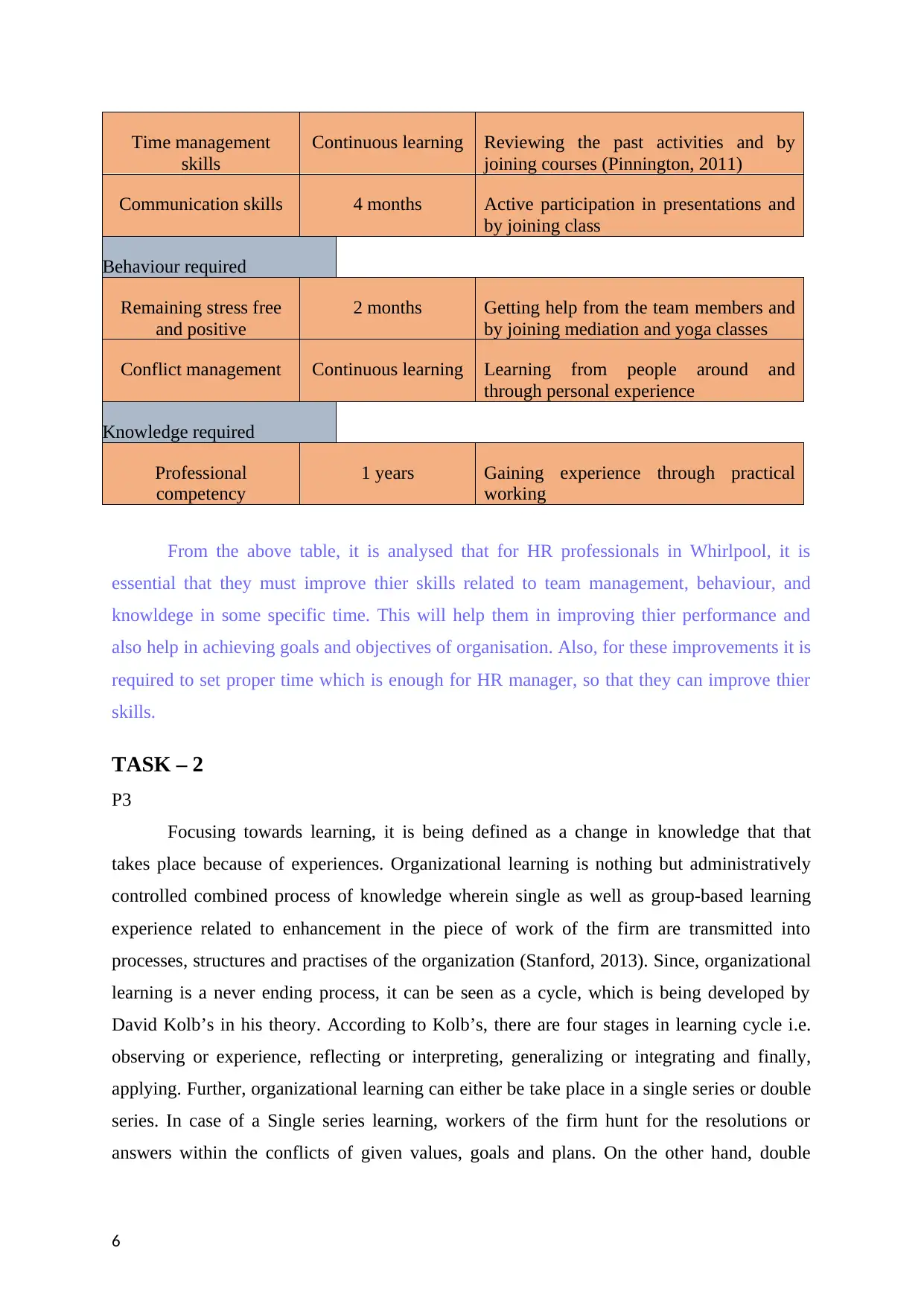
Time management
skills
Continuous learning Reviewing the past activities and by
joining courses (Pinnington, 2011)
Communication skills 4 months Active participation in presentations and
by joining class
Behaviour required
Remaining stress free
and positive
2 months Getting help from the team members and
by joining mediation and yoga classes
Conflict management Continuous learning Learning from people around and
through personal experience
Knowledge required
Professional
competency
1 years Gaining experience through practical
working
From the above table, it is analysed that for HR professionals in Whirlpool, it is
essential that they must improve thier skills related to team management, behaviour, and
knowldege in some specific time. This will help them in improving thier performance and
also help in achieving goals and objectives of organisation. Also, for these improvements it is
required to set proper time which is enough for HR manager, so that they can improve thier
skills.
TASK – 2
P3
Focusing towards learning, it is being defined as a change in knowledge that that
takes place because of experiences. Organizational learning is nothing but administratively
controlled combined process of knowledge wherein single as well as group-based learning
experience related to enhancement in the piece of work of the firm are transmitted into
processes, structures and practises of the organization (Stanford, 2013). Since, organizational
learning is a never ending process, it can be seen as a cycle, which is being developed by
David Kolb’s in his theory. According to Kolb’s, there are four stages in learning cycle i.e.
observing or experience, reflecting or interpreting, generalizing or integrating and finally,
applying. Further, organizational learning can either be take place in a single series or double
series. In case of a Single series learning, workers of the firm hunt for the resolutions or
answers within the conflicts of given values, goals and plans. On the other hand, double
6
skills
Continuous learning Reviewing the past activities and by
joining courses (Pinnington, 2011)
Communication skills 4 months Active participation in presentations and
by joining class
Behaviour required
Remaining stress free
and positive
2 months Getting help from the team members and
by joining mediation and yoga classes
Conflict management Continuous learning Learning from people around and
through personal experience
Knowledge required
Professional
competency
1 years Gaining experience through practical
working
From the above table, it is analysed that for HR professionals in Whirlpool, it is
essential that they must improve thier skills related to team management, behaviour, and
knowldege in some specific time. This will help them in improving thier performance and
also help in achieving goals and objectives of organisation. Also, for these improvements it is
required to set proper time which is enough for HR manager, so that they can improve thier
skills.
TASK – 2
P3
Focusing towards learning, it is being defined as a change in knowledge that that
takes place because of experiences. Organizational learning is nothing but administratively
controlled combined process of knowledge wherein single as well as group-based learning
experience related to enhancement in the piece of work of the firm are transmitted into
processes, structures and practises of the organization (Stanford, 2013). Since, organizational
learning is a never ending process, it can be seen as a cycle, which is being developed by
David Kolb’s in his theory. According to Kolb’s, there are four stages in learning cycle i.e.
observing or experience, reflecting or interpreting, generalizing or integrating and finally,
applying. Further, organizational learning can either be take place in a single series or double
series. In case of a Single series learning, workers of the firm hunt for the resolutions or
answers within the conflicts of given values, goals and plans. On the other hand, double
6
⊘ This is a preview!⊘
Do you want full access?
Subscribe today to unlock all pages.

Trusted by 1+ million students worldwide
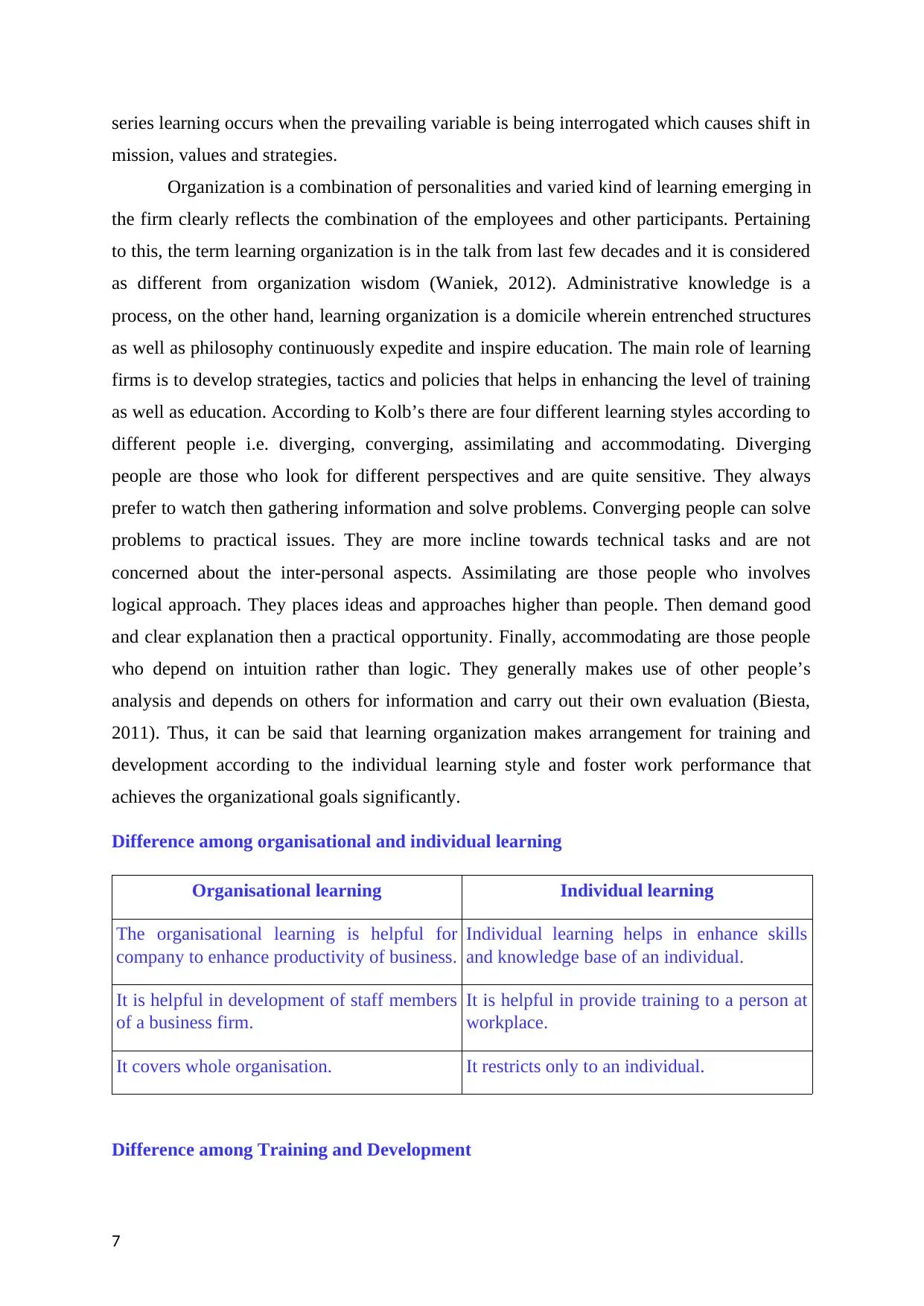
series learning occurs when the prevailing variable is being interrogated which causes shift in
mission, values and strategies.
Organization is a combination of personalities and varied kind of learning emerging in
the firm clearly reflects the combination of the employees and other participants. Pertaining
to this, the term learning organization is in the talk from last few decades and it is considered
as different from organization wisdom (Waniek, 2012). Administrative knowledge is a
process, on the other hand, learning organization is a domicile wherein entrenched structures
as well as philosophy continuously expedite and inspire education. The main role of learning
firms is to develop strategies, tactics and policies that helps in enhancing the level of training
as well as education. According to Kolb’s there are four different learning styles according to
different people i.e. diverging, converging, assimilating and accommodating. Diverging
people are those who look for different perspectives and are quite sensitive. They always
prefer to watch then gathering information and solve problems. Converging people can solve
problems to practical issues. They are more incline towards technical tasks and are not
concerned about the inter-personal aspects. Assimilating are those people who involves
logical approach. They places ideas and approaches higher than people. Then demand good
and clear explanation then a practical opportunity. Finally, accommodating are those people
who depend on intuition rather than logic. They generally makes use of other people’s
analysis and depends on others for information and carry out their own evaluation (Biesta,
2011). Thus, it can be said that learning organization makes arrangement for training and
development according to the individual learning style and foster work performance that
achieves the organizational goals significantly.
Difference among organisational and individual learning
Organisational learning Individual learning
The organisational learning is helpful for
company to enhance productivity of business.
Individual learning helps in enhance skills
and knowledge base of an individual.
It is helpful in development of staff members
of a business firm.
It is helpful in provide training to a person at
workplace.
It covers whole organisation. It restricts only to an individual.
Difference among Training and Development
7
mission, values and strategies.
Organization is a combination of personalities and varied kind of learning emerging in
the firm clearly reflects the combination of the employees and other participants. Pertaining
to this, the term learning organization is in the talk from last few decades and it is considered
as different from organization wisdom (Waniek, 2012). Administrative knowledge is a
process, on the other hand, learning organization is a domicile wherein entrenched structures
as well as philosophy continuously expedite and inspire education. The main role of learning
firms is to develop strategies, tactics and policies that helps in enhancing the level of training
as well as education. According to Kolb’s there are four different learning styles according to
different people i.e. diverging, converging, assimilating and accommodating. Diverging
people are those who look for different perspectives and are quite sensitive. They always
prefer to watch then gathering information and solve problems. Converging people can solve
problems to practical issues. They are more incline towards technical tasks and are not
concerned about the inter-personal aspects. Assimilating are those people who involves
logical approach. They places ideas and approaches higher than people. Then demand good
and clear explanation then a practical opportunity. Finally, accommodating are those people
who depend on intuition rather than logic. They generally makes use of other people’s
analysis and depends on others for information and carry out their own evaluation (Biesta,
2011). Thus, it can be said that learning organization makes arrangement for training and
development according to the individual learning style and foster work performance that
achieves the organizational goals significantly.
Difference among organisational and individual learning
Organisational learning Individual learning
The organisational learning is helpful for
company to enhance productivity of business.
Individual learning helps in enhance skills
and knowledge base of an individual.
It is helpful in development of staff members
of a business firm.
It is helpful in provide training to a person at
workplace.
It covers whole organisation. It restricts only to an individual.
Difference among Training and Development
7
Paraphrase This Document
Need a fresh take? Get an instant paraphrase of this document with our AI Paraphraser
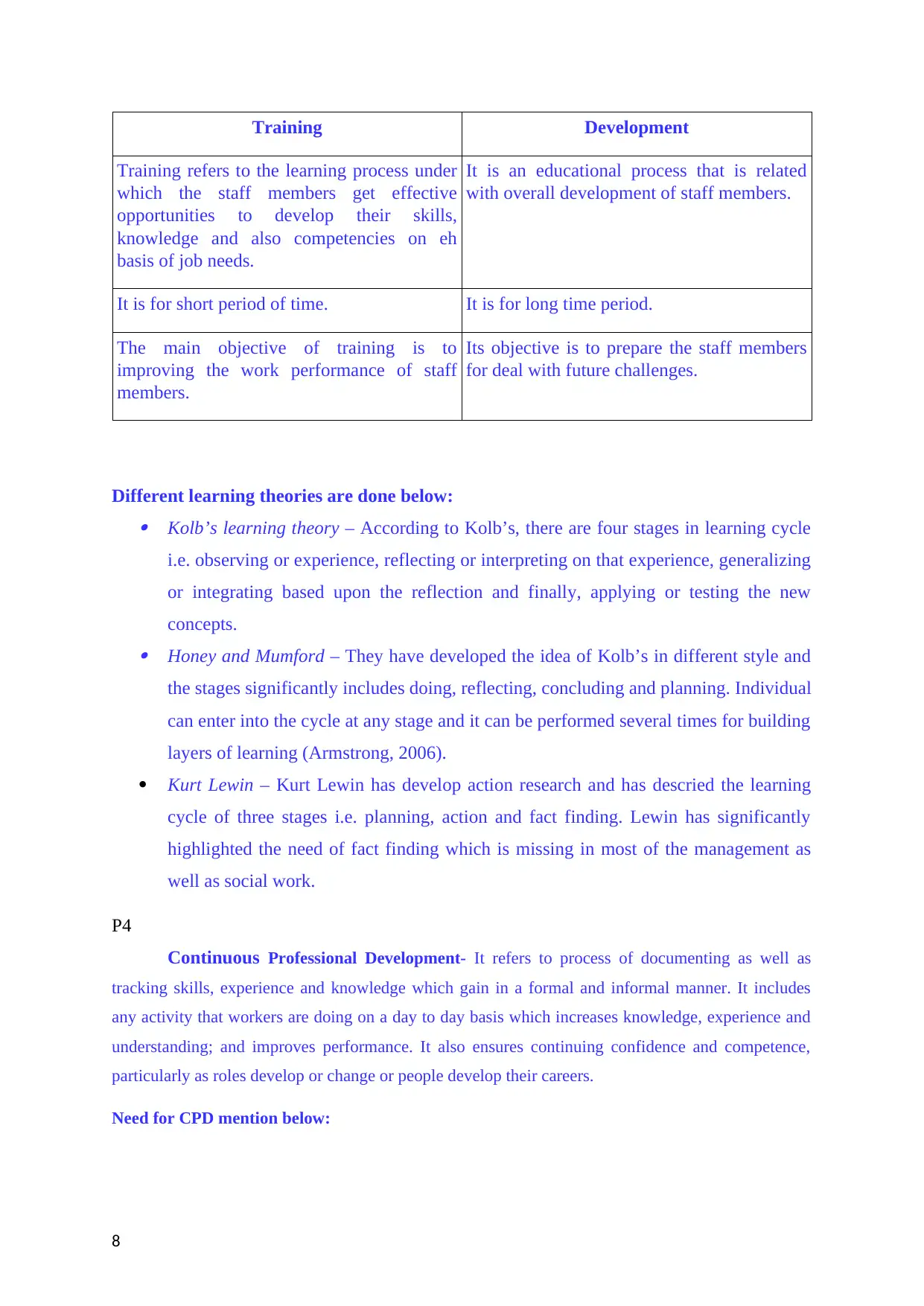
Training Development
Training refers to the learning process under
which the staff members get effective
opportunities to develop their skills,
knowledge and also competencies on eh
basis of job needs.
It is an educational process that is related
with overall development of staff members.
It is for short period of time. It is for long time period.
The main objective of training is to
improving the work performance of staff
members.
Its objective is to prepare the staff members
for deal with future challenges.
Different learning theories are done below: Kolb’s learning theory – According to Kolb’s, there are four stages in learning cycle
i.e. observing or experience, reflecting or interpreting on that experience, generalizing
or integrating based upon the reflection and finally, applying or testing the new
concepts. Honey and Mumford – They have developed the idea of Kolb’s in different style and
the stages significantly includes doing, reflecting, concluding and planning. Individual
can enter into the cycle at any stage and it can be performed several times for building
layers of learning (Armstrong, 2006).
Kurt Lewin – Kurt Lewin has develop action research and has descried the learning
cycle of three stages i.e. planning, action and fact finding. Lewin has significantly
highlighted the need of fact finding which is missing in most of the management as
well as social work.
P4
Continuous Professional Development- It refers to process of documenting as well as
tracking skills, experience and knowledge which gain in a formal and informal manner. It includes
any activity that workers are doing on a day to day basis which increases knowledge, experience and
understanding; and improves performance. It also ensures continuing confidence and competence,
particularly as roles develop or change or people develop their careers.
Need for CPD mention below:
8
Training refers to the learning process under
which the staff members get effective
opportunities to develop their skills,
knowledge and also competencies on eh
basis of job needs.
It is an educational process that is related
with overall development of staff members.
It is for short period of time. It is for long time period.
The main objective of training is to
improving the work performance of staff
members.
Its objective is to prepare the staff members
for deal with future challenges.
Different learning theories are done below: Kolb’s learning theory – According to Kolb’s, there are four stages in learning cycle
i.e. observing or experience, reflecting or interpreting on that experience, generalizing
or integrating based upon the reflection and finally, applying or testing the new
concepts. Honey and Mumford – They have developed the idea of Kolb’s in different style and
the stages significantly includes doing, reflecting, concluding and planning. Individual
can enter into the cycle at any stage and it can be performed several times for building
layers of learning (Armstrong, 2006).
Kurt Lewin – Kurt Lewin has develop action research and has descried the learning
cycle of three stages i.e. planning, action and fact finding. Lewin has significantly
highlighted the need of fact finding which is missing in most of the management as
well as social work.
P4
Continuous Professional Development- It refers to process of documenting as well as
tracking skills, experience and knowledge which gain in a formal and informal manner. It includes
any activity that workers are doing on a day to day basis which increases knowledge, experience and
understanding; and improves performance. It also ensures continuing confidence and competence,
particularly as roles develop or change or people develop their careers.
Need for CPD mention below:
8
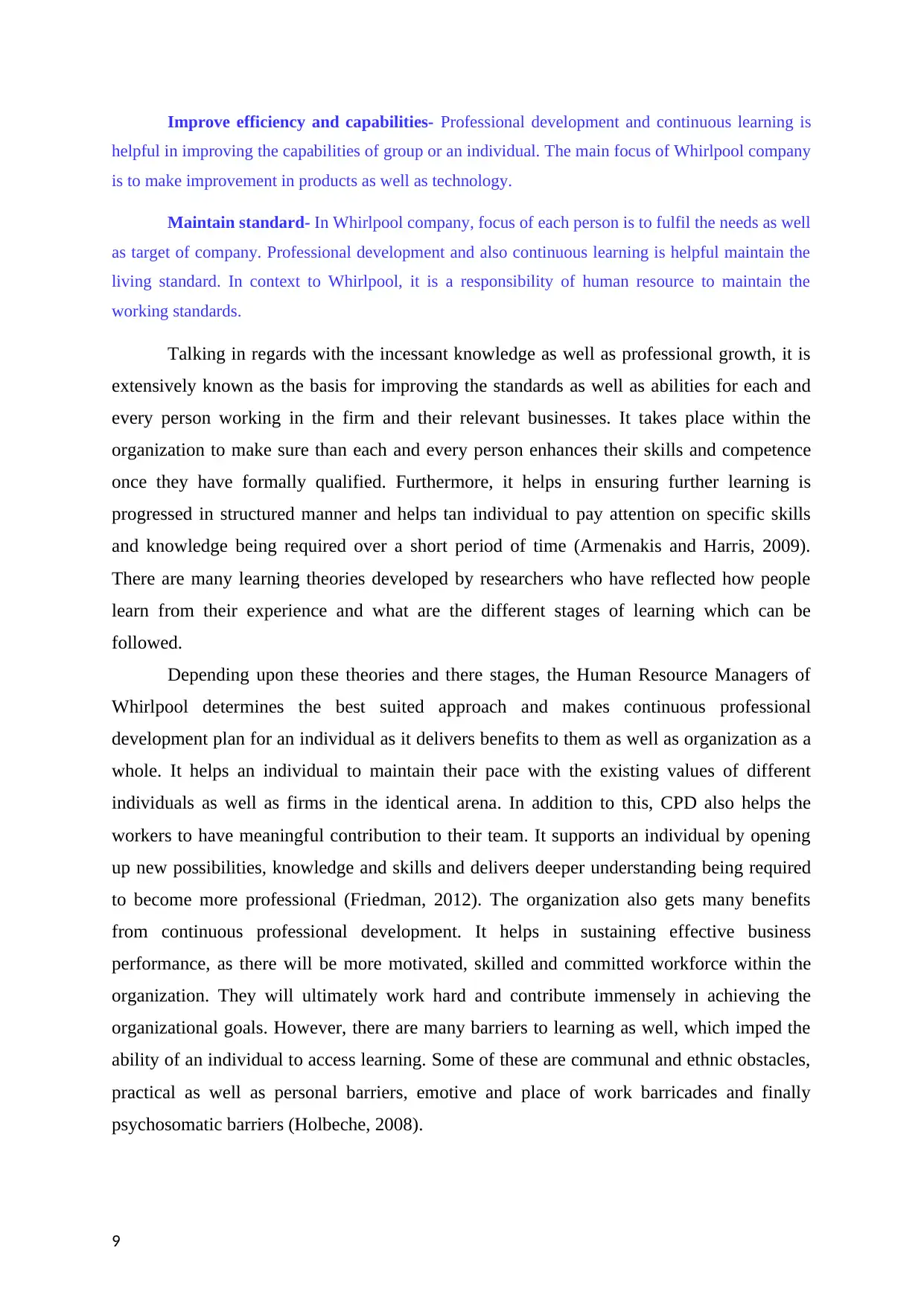
Improve efficiency and capabilities- Professional development and continuous learning is
helpful in improving the capabilities of group or an individual. The main focus of Whirlpool company
is to make improvement in products as well as technology.
Maintain standard- In Whirlpool company, focus of each person is to fulfil the needs as well
as target of company. Professional development and also continuous learning is helpful maintain the
living standard. In context to Whirlpool, it is a responsibility of human resource to maintain the
working standards.
Talking in regards with the incessant knowledge as well as professional growth, it is
extensively known as the basis for improving the standards as well as abilities for each and
every person working in the firm and their relevant businesses. It takes place within the
organization to make sure than each and every person enhances their skills and competence
once they have formally qualified. Furthermore, it helps in ensuring further learning is
progressed in structured manner and helps tan individual to pay attention on specific skills
and knowledge being required over a short period of time (Armenakis and Harris, 2009).
There are many learning theories developed by researchers who have reflected how people
learn from their experience and what are the different stages of learning which can be
followed.
Depending upon these theories and there stages, the Human Resource Managers of
Whirlpool determines the best suited approach and makes continuous professional
development plan for an individual as it delivers benefits to them as well as organization as a
whole. It helps an individual to maintain their pace with the existing values of different
individuals as well as firms in the identical arena. In addition to this, CPD also helps the
workers to have meaningful contribution to their team. It supports an individual by opening
up new possibilities, knowledge and skills and delivers deeper understanding being required
to become more professional (Friedman, 2012). The organization also gets many benefits
from continuous professional development. It helps in sustaining effective business
performance, as there will be more motivated, skilled and committed workforce within the
organization. They will ultimately work hard and contribute immensely in achieving the
organizational goals. However, there are many barriers to learning as well, which imped the
ability of an individual to access learning. Some of these are communal and ethnic obstacles,
practical as well as personal barriers, emotive and place of work barricades and finally
psychosomatic barriers (Holbeche, 2008).
9
helpful in improving the capabilities of group or an individual. The main focus of Whirlpool company
is to make improvement in products as well as technology.
Maintain standard- In Whirlpool company, focus of each person is to fulfil the needs as well
as target of company. Professional development and also continuous learning is helpful maintain the
living standard. In context to Whirlpool, it is a responsibility of human resource to maintain the
working standards.
Talking in regards with the incessant knowledge as well as professional growth, it is
extensively known as the basis for improving the standards as well as abilities for each and
every person working in the firm and their relevant businesses. It takes place within the
organization to make sure than each and every person enhances their skills and competence
once they have formally qualified. Furthermore, it helps in ensuring further learning is
progressed in structured manner and helps tan individual to pay attention on specific skills
and knowledge being required over a short period of time (Armenakis and Harris, 2009).
There are many learning theories developed by researchers who have reflected how people
learn from their experience and what are the different stages of learning which can be
followed.
Depending upon these theories and there stages, the Human Resource Managers of
Whirlpool determines the best suited approach and makes continuous professional
development plan for an individual as it delivers benefits to them as well as organization as a
whole. It helps an individual to maintain their pace with the existing values of different
individuals as well as firms in the identical arena. In addition to this, CPD also helps the
workers to have meaningful contribution to their team. It supports an individual by opening
up new possibilities, knowledge and skills and delivers deeper understanding being required
to become more professional (Friedman, 2012). The organization also gets many benefits
from continuous professional development. It helps in sustaining effective business
performance, as there will be more motivated, skilled and committed workforce within the
organization. They will ultimately work hard and contribute immensely in achieving the
organizational goals. However, there are many barriers to learning as well, which imped the
ability of an individual to access learning. Some of these are communal and ethnic obstacles,
practical as well as personal barriers, emotive and place of work barricades and finally
psychosomatic barriers (Holbeche, 2008).
9
⊘ This is a preview!⊘
Do you want full access?
Subscribe today to unlock all pages.

Trusted by 1+ million students worldwide
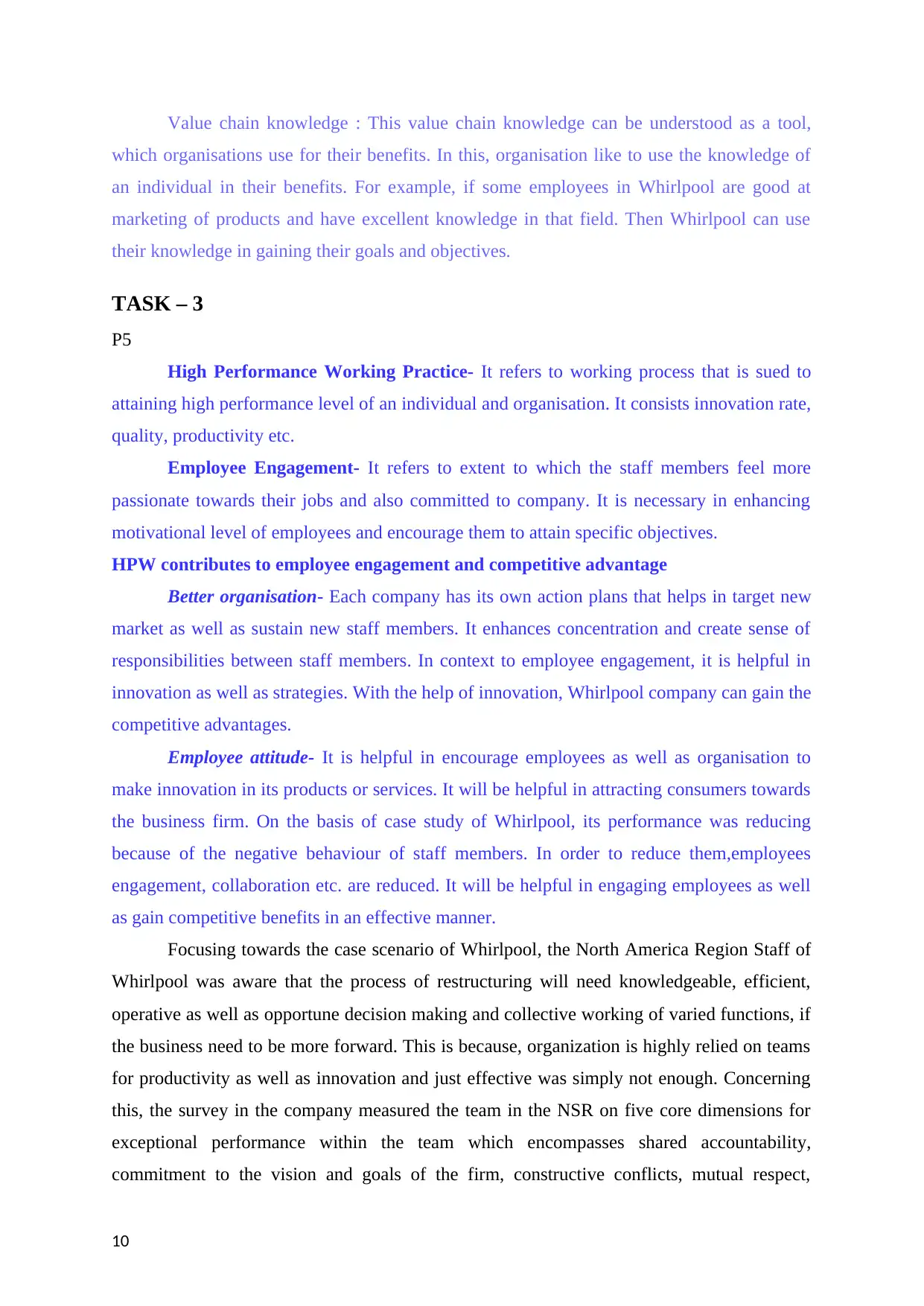
Value chain knowledge : This value chain knowledge can be understood as a tool,
which organisations use for their benefits. In this, organisation like to use the knowledge of
an individual in their benefits. For example, if some employees in Whirlpool are good at
marketing of products and have excellent knowledge in that field. Then Whirlpool can use
their knowledge in gaining their goals and objectives.
TASK – 3
P5
High Performance Working Practice- It refers to working process that is sued to
attaining high performance level of an individual and organisation. It consists innovation rate,
quality, productivity etc.
Employee Engagement- It refers to extent to which the staff members feel more
passionate towards their jobs and also committed to company. It is necessary in enhancing
motivational level of employees and encourage them to attain specific objectives.
HPW contributes to employee engagement and competitive advantage
Better organisation- Each company has its own action plans that helps in target new
market as well as sustain new staff members. It enhances concentration and create sense of
responsibilities between staff members. In context to employee engagement, it is helpful in
innovation as well as strategies. With the help of innovation, Whirlpool company can gain the
competitive advantages.
Employee attitude- It is helpful in encourage employees as well as organisation to
make innovation in its products or services. It will be helpful in attracting consumers towards
the business firm. On the basis of case study of Whirlpool, its performance was reducing
because of the negative behaviour of staff members. In order to reduce them,employees
engagement, collaboration etc. are reduced. It will be helpful in engaging employees as well
as gain competitive benefits in an effective manner.
Focusing towards the case scenario of Whirlpool, the North America Region Staff of
Whirlpool was aware that the process of restructuring will need knowledgeable, efficient,
operative as well as opportune decision making and collective working of varied functions, if
the business need to be more forward. This is because, organization is highly relied on teams
for productivity as well as innovation and just effective was simply not enough. Concerning
this, the survey in the company measured the team in the NSR on five core dimensions for
exceptional performance within the team which encompasses shared accountability,
commitment to the vision and goals of the firm, constructive conflicts, mutual respect,
10
which organisations use for their benefits. In this, organisation like to use the knowledge of
an individual in their benefits. For example, if some employees in Whirlpool are good at
marketing of products and have excellent knowledge in that field. Then Whirlpool can use
their knowledge in gaining their goals and objectives.
TASK – 3
P5
High Performance Working Practice- It refers to working process that is sued to
attaining high performance level of an individual and organisation. It consists innovation rate,
quality, productivity etc.
Employee Engagement- It refers to extent to which the staff members feel more
passionate towards their jobs and also committed to company. It is necessary in enhancing
motivational level of employees and encourage them to attain specific objectives.
HPW contributes to employee engagement and competitive advantage
Better organisation- Each company has its own action plans that helps in target new
market as well as sustain new staff members. It enhances concentration and create sense of
responsibilities between staff members. In context to employee engagement, it is helpful in
innovation as well as strategies. With the help of innovation, Whirlpool company can gain the
competitive advantages.
Employee attitude- It is helpful in encourage employees as well as organisation to
make innovation in its products or services. It will be helpful in attracting consumers towards
the business firm. On the basis of case study of Whirlpool, its performance was reducing
because of the negative behaviour of staff members. In order to reduce them,employees
engagement, collaboration etc. are reduced. It will be helpful in engaging employees as well
as gain competitive benefits in an effective manner.
Focusing towards the case scenario of Whirlpool, the North America Region Staff of
Whirlpool was aware that the process of restructuring will need knowledgeable, efficient,
operative as well as opportune decision making and collective working of varied functions, if
the business need to be more forward. This is because, organization is highly relied on teams
for productivity as well as innovation and just effective was simply not enough. Concerning
this, the survey in the company measured the team in the NSR on five core dimensions for
exceptional performance within the team which encompasses shared accountability,
commitment to the vision and goals of the firm, constructive conflicts, mutual respect,
10
Paraphrase This Document
Need a fresh take? Get an instant paraphrase of this document with our AI Paraphraser
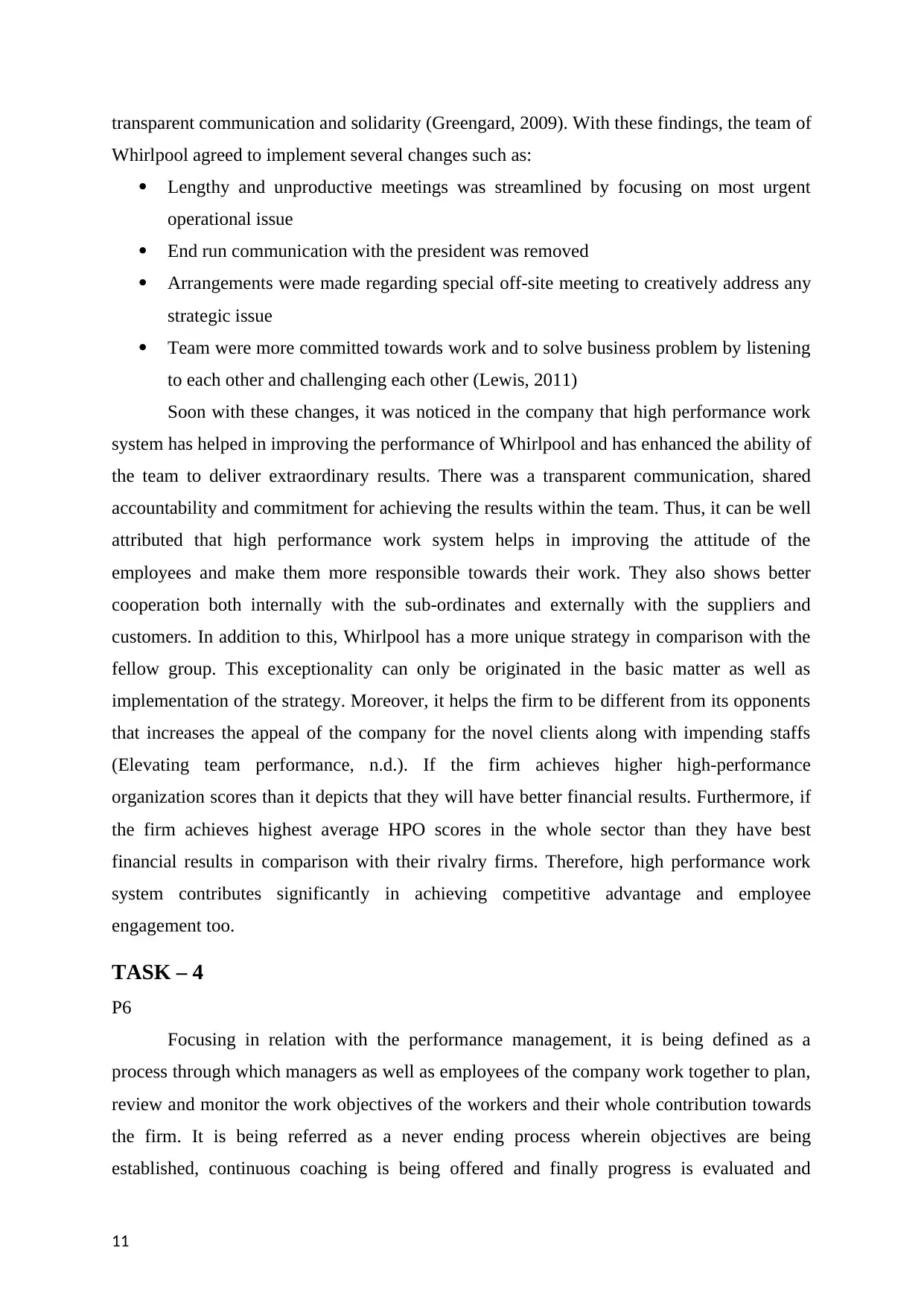
transparent communication and solidarity (Greengard, 2009). With these findings, the team of
Whirlpool agreed to implement several changes such as:
Lengthy and unproductive meetings was streamlined by focusing on most urgent
operational issue
End run communication with the president was removed
Arrangements were made regarding special off-site meeting to creatively address any
strategic issue
Team were more committed towards work and to solve business problem by listening
to each other and challenging each other (Lewis, 2011)
Soon with these changes, it was noticed in the company that high performance work
system has helped in improving the performance of Whirlpool and has enhanced the ability of
the team to deliver extraordinary results. There was a transparent communication, shared
accountability and commitment for achieving the results within the team. Thus, it can be well
attributed that high performance work system helps in improving the attitude of the
employees and make them more responsible towards their work. They also shows better
cooperation both internally with the sub-ordinates and externally with the suppliers and
customers. In addition to this, Whirlpool has a more unique strategy in comparison with the
fellow group. This exceptionality can only be originated in the basic matter as well as
implementation of the strategy. Moreover, it helps the firm to be different from its opponents
that increases the appeal of the company for the novel clients along with impending staffs
(Elevating team performance, n.d.). If the firm achieves higher high-performance
organization scores than it depicts that they will have better financial results. Furthermore, if
the firm achieves highest average HPO scores in the whole sector than they have best
financial results in comparison with their rivalry firms. Therefore, high performance work
system contributes significantly in achieving competitive advantage and employee
engagement too.
TASK – 4
P6
Focusing in relation with the performance management, it is being defined as a
process through which managers as well as employees of the company work together to plan,
review and monitor the work objectives of the workers and their whole contribution towards
the firm. It is being referred as a never ending process wherein objectives are being
established, continuous coaching is being offered and finally progress is evaluated and
11
Whirlpool agreed to implement several changes such as:
Lengthy and unproductive meetings was streamlined by focusing on most urgent
operational issue
End run communication with the president was removed
Arrangements were made regarding special off-site meeting to creatively address any
strategic issue
Team were more committed towards work and to solve business problem by listening
to each other and challenging each other (Lewis, 2011)
Soon with these changes, it was noticed in the company that high performance work
system has helped in improving the performance of Whirlpool and has enhanced the ability of
the team to deliver extraordinary results. There was a transparent communication, shared
accountability and commitment for achieving the results within the team. Thus, it can be well
attributed that high performance work system helps in improving the attitude of the
employees and make them more responsible towards their work. They also shows better
cooperation both internally with the sub-ordinates and externally with the suppliers and
customers. In addition to this, Whirlpool has a more unique strategy in comparison with the
fellow group. This exceptionality can only be originated in the basic matter as well as
implementation of the strategy. Moreover, it helps the firm to be different from its opponents
that increases the appeal of the company for the novel clients along with impending staffs
(Elevating team performance, n.d.). If the firm achieves higher high-performance
organization scores than it depicts that they will have better financial results. Furthermore, if
the firm achieves highest average HPO scores in the whole sector than they have best
financial results in comparison with their rivalry firms. Therefore, high performance work
system contributes significantly in achieving competitive advantage and employee
engagement too.
TASK – 4
P6
Focusing in relation with the performance management, it is being defined as a
process through which managers as well as employees of the company work together to plan,
review and monitor the work objectives of the workers and their whole contribution towards
the firm. It is being referred as a never ending process wherein objectives are being
established, continuous coaching is being offered and finally progress is evaluated and
11
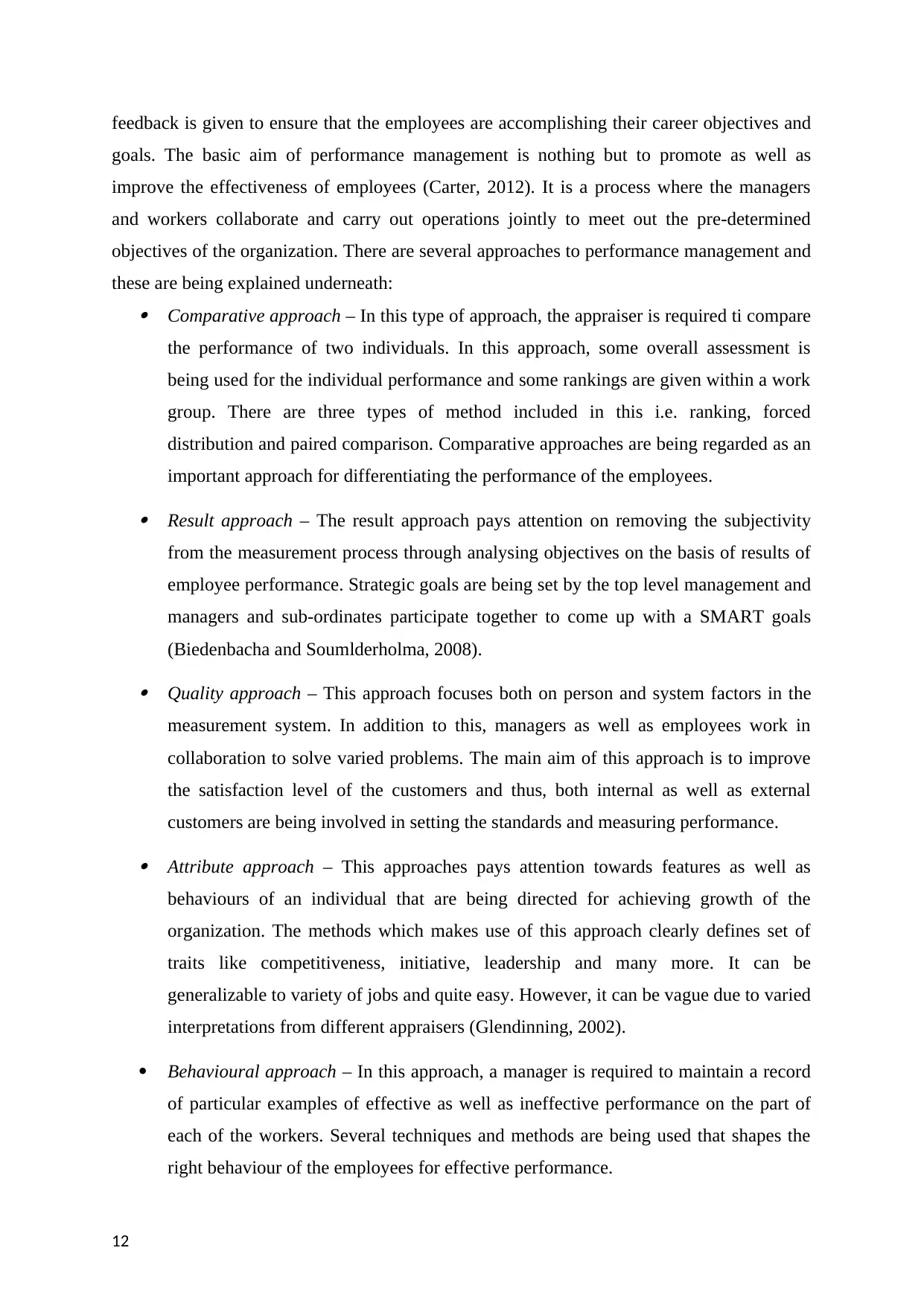
feedback is given to ensure that the employees are accomplishing their career objectives and
goals. The basic aim of performance management is nothing but to promote as well as
improve the effectiveness of employees (Carter, 2012). It is a process where the managers
and workers collaborate and carry out operations jointly to meet out the pre-determined
objectives of the organization. There are several approaches to performance management and
these are being explained underneath: Comparative approach – In this type of approach, the appraiser is required ti compare
the performance of two individuals. In this approach, some overall assessment is
being used for the individual performance and some rankings are given within a work
group. There are three types of method included in this i.e. ranking, forced
distribution and paired comparison. Comparative approaches are being regarded as an
important approach for differentiating the performance of the employees. Result approach – The result approach pays attention on removing the subjectivity
from the measurement process through analysing objectives on the basis of results of
employee performance. Strategic goals are being set by the top level management and
managers and sub-ordinates participate together to come up with a SMART goals
(Biedenbacha and Soumlderholma, 2008). Quality approach – This approach focuses both on person and system factors in the
measurement system. In addition to this, managers as well as employees work in
collaboration to solve varied problems. The main aim of this approach is to improve
the satisfaction level of the customers and thus, both internal as well as external
customers are being involved in setting the standards and measuring performance. Attribute approach – This approaches pays attention towards features as well as
behaviours of an individual that are being directed for achieving growth of the
organization. The methods which makes use of this approach clearly defines set of
traits like competitiveness, initiative, leadership and many more. It can be
generalizable to variety of jobs and quite easy. However, it can be vague due to varied
interpretations from different appraisers (Glendinning, 2002).
Behavioural approach – In this approach, a manager is required to maintain a record
of particular examples of effective as well as ineffective performance on the part of
each of the workers. Several techniques and methods are being used that shapes the
right behaviour of the employees for effective performance.
12
goals. The basic aim of performance management is nothing but to promote as well as
improve the effectiveness of employees (Carter, 2012). It is a process where the managers
and workers collaborate and carry out operations jointly to meet out the pre-determined
objectives of the organization. There are several approaches to performance management and
these are being explained underneath: Comparative approach – In this type of approach, the appraiser is required ti compare
the performance of two individuals. In this approach, some overall assessment is
being used for the individual performance and some rankings are given within a work
group. There are three types of method included in this i.e. ranking, forced
distribution and paired comparison. Comparative approaches are being regarded as an
important approach for differentiating the performance of the employees. Result approach – The result approach pays attention on removing the subjectivity
from the measurement process through analysing objectives on the basis of results of
employee performance. Strategic goals are being set by the top level management and
managers and sub-ordinates participate together to come up with a SMART goals
(Biedenbacha and Soumlderholma, 2008). Quality approach – This approach focuses both on person and system factors in the
measurement system. In addition to this, managers as well as employees work in
collaboration to solve varied problems. The main aim of this approach is to improve
the satisfaction level of the customers and thus, both internal as well as external
customers are being involved in setting the standards and measuring performance. Attribute approach – This approaches pays attention towards features as well as
behaviours of an individual that are being directed for achieving growth of the
organization. The methods which makes use of this approach clearly defines set of
traits like competitiveness, initiative, leadership and many more. It can be
generalizable to variety of jobs and quite easy. However, it can be vague due to varied
interpretations from different appraisers (Glendinning, 2002).
Behavioural approach – In this approach, a manager is required to maintain a record
of particular examples of effective as well as ineffective performance on the part of
each of the workers. Several techniques and methods are being used that shapes the
right behaviour of the employees for effective performance.
12
⊘ This is a preview!⊘
Do you want full access?
Subscribe today to unlock all pages.

Trusted by 1+ million students worldwide
1 out of 15
Related Documents
Your All-in-One AI-Powered Toolkit for Academic Success.
+13062052269
info@desklib.com
Available 24*7 on WhatsApp / Email
![[object Object]](/_next/static/media/star-bottom.7253800d.svg)
Unlock your academic potential
Copyright © 2020–2025 A2Z Services. All Rights Reserved. Developed and managed by ZUCOL.





